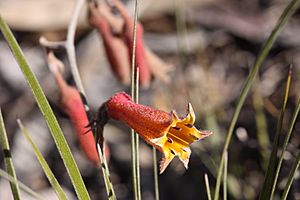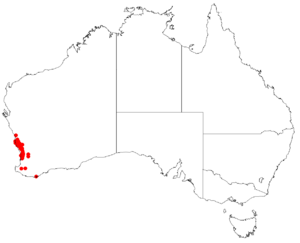Winter bell facts for kids
Quick facts for kids Winter bell |
|
|---|---|
 |
|
| Flower at Lesueur National Park, Western Australia | |
| Scientific classification | |
| Genus: |
Blancoa
|
| Species: |
canescens
|
 |
|
| Collection data from Australasian Virtual Herbarium of Blancoa canescens | |
| Synonyms | |
|
|
The Blancoa canescens, often called the winter bell, is a special plant. It's the only type of plant in its group, called a genus, named Blancoa. This plant is a perennial herb, meaning it lives for more than two years. It belongs to the plant family Haemodoraceae.
The winter bell plant is found only in the southwestern part of Western Australia. It has pretty red to pink flowers that hang downwards. It grows in clumps and can reach a height of 10 to 40 centimeters (about 4 to 16 inches). The Blancoa genus was named after Francisco Manuel Blanco. He was a Spanish friar and botanist who studied plants in the Philippines.
What Does the Winter Bell Look Like?
The winter bell is a plant that grows in clumps. It has a special root system called a rhizome. This root system helps the plant spread underground. From these roots, tufts of long, thin leaves grow. These leaves are about 25 centimeters (10 inches) long and 0.5 centimeters (0.2 inches) wide. They have smooth edges and straight veins. When the leaves are young, they are covered with soft, silky hairs.
Flowers and Pollination
The flowers of the winter bell are pink or red and hang downwards. They are about 3 centimeters (1.2 inches) long and have yellowish insides. These flowers grow in pairs on a spike, which is a type of flower stalk. The plant blooms during the wet season, from May to September.
The outside of the tube-shaped flowers is covered with fine, reddish-brown hairs. But the inside of the flower is smooth. At the bottom of the flower tube, there is a nectary. This part makes a lot of sweet liquid called nectar. Birds love to drink this nectar!
Birds help to pollinate the winter bell flowers. The main birds that do this are the singing honeyeater and the red wattlebird. Other birds and even bees might also visit the flowers. Larger birds stand on the ground and reach up to sip the nectar. Smaller birds might hang onto the flower stalk, called a pedicel. As they drink, their heads and beaks get covered with pollen. After the flowers are pollinated, they fade and dry up. But they stay on the plant while the fruits grow inside.
Where Does the Winter Bell Grow?
The winter bell plant is found only in a specific area. This area is the coastal part of southwestern Western Australia. You can find it in places like the Shire of Irwin and the Shire of Gingin. These areas are part of the Southwest botanical province.
The plant grows best in deep sand. It lives in areas with Banksia woodland. It also grows in a type of open scrubland called kwongan. This region has a Mediterranean climate. This means it has cool, wet winters and hot, dry summers.

